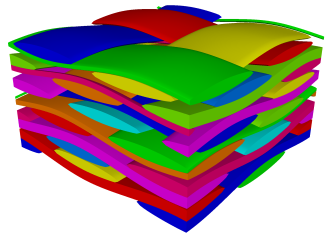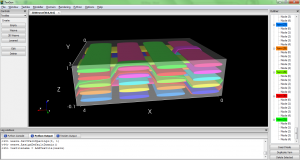
April 27, 2017, by Jim Wilson
Evidencing the Impact of TexGen Software
TexGen is an open source piece of software that models the geometry of textile structures. Developed here at the Faculty of Engineering of the University of Nottingham and made freely available to the research and industrial communities through a General Public Licence, it is currently hosted and distributed on the SourceForge site. TexGen Website
TexGen is an ideal candidate for an impact case study in a future Research Excellence Framework (REF) exercise, and SourceForge already make available a small amount of usage information, limited to the number of downloads and their country of origin. Additional usage data is required in order to provide hard evidence to support and evidence the impact that TexGen in having, in order to allow the submission of an impact case study at the next REF.
The Digital Research team was engaged at an early stage, when the researchers had decided to apply for funding (from EPSRC’s Impact Accelerator Account) to design and implement a solution to provide the necessary additional information.
Various options for collecting additional usage information were considered, including moving the hosting to a different site, which would give greater control over registration and downloads, by in effect hiding the software behind a ‘registration wall’. However it was decided early on that the software should remain hosted and distributed via SourceForce, to preserve the existing user base and not disrupt existing users of the software in any way as this could potentially diminish the impact that TexGen is having.

The TexGen GUI.
Input from Information Services User Experience group, recommended an optional registration process, hosted externally in the form of a questionnaire, which would be linked to by the software package. Having the survey hosted externally (rather than integrated into TexGen’s code) gives far greater flexibility to modify and adapt the survey questions in the future, without having to release an updated version of the software package.
The Digital Research team, working in conjunction with colleagues from Engineering and Information Services were able to help support the researcher in putting together an application for funding to EPSRC’s IAA, including a fully costed and supported solution and all staffing and support needed to implement and maintain the system over the life time of the project.
Following the successful award of funds the solution which had been designed was rapidly implemented as designed and is now live and collecting additional information from TexGen’s user community. This additional information will greatly enhance the Impact Case for TexGen and is helping to build relationships between the developers and the user community.
A second phase of the project will be looking at collecting additional data around the page, examining the use of tools such as google analytics, to supplement the information being collected through the survey tool with more detailed download and usage information.
Building on from the collection of this raw data, it will be necessary to conduct a piece of work examining the data in more detail and formulating it into a robust case study for the next REF. This may involve discussions between the developers and selected external users to evidence in detail what effect TexGen is having, through a series of ‘use cases’.
Can we help you?
This type of approach could easily be applied to other research software tools produced here at Nottingham. If you have a piece of research software and you’d be interested in exploring the options, please do get in touch with the digital research team to discuss what would be possible. Digital Research Team
Jim Wilson, Digital Research Specialist for Engineering
No comments yet, fill out a comment to be the first

Leave a Reply